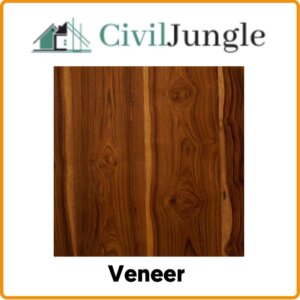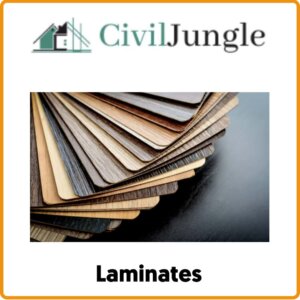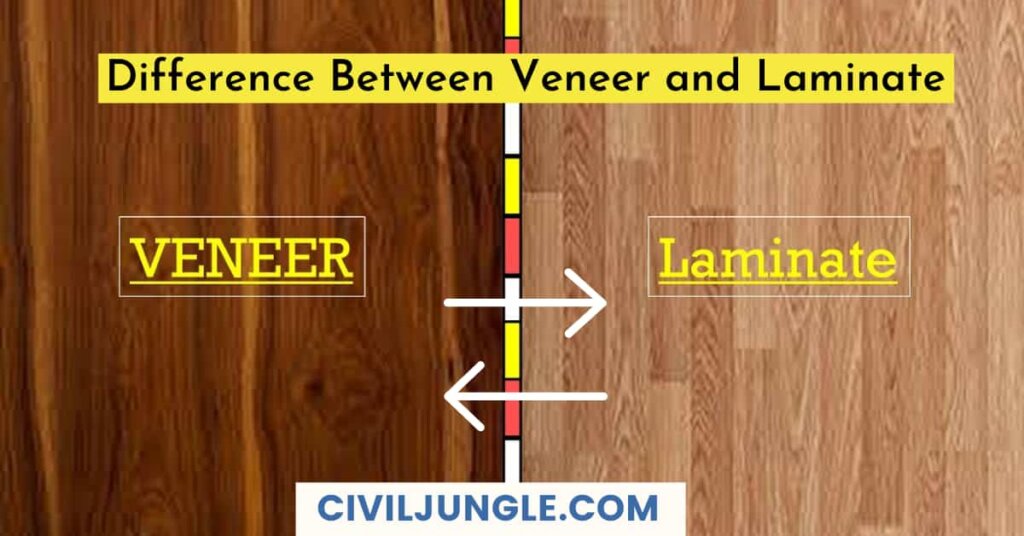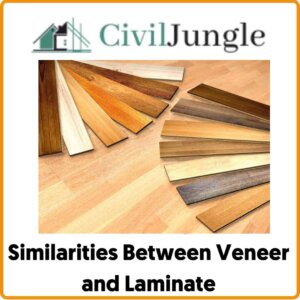
What Is Veneers?

They look like real wood since veneers are sourced from trees where every sheet of veneer has a unique appearance. No two sheets of veneer appear identical, unlike laminates.
Design of Veneers
The natural wood grain patterns offer a rich, warm and aesthetically pleasing appearance to the veneer sheets. In addition, veneers may be stained in various colours and finishes, such as gloss and matte.
Polishing of Veneers
One downside is that veneers are vulnerable to scratching over a period of time and the polishing peels off. However, the veneer surface can be sanded and polished to achieve its original appearance, much like wood.
Maintenance Service of Veneers
Since they’re not waterproof and could get affected by heat, veneers need periodic maintenance. In moisture-laden areas such as kitchens and bathrooms, veneer finishes must therefore be prevented as moisture can make its way there under the veneer and lose the upper surface.
Remember that a layer of melamine will make the layer of the veneer waterproof.
Environment-Friendly Veneers
Since these are generated from either a resource that is renewable, veneers are sustainable. Laminates, though, include plastics and resins that can end up over a period of time in landfills.
Costs of Veneers
Although veneer sheets are crafted with thin layers of real wood, these are more expensive than laminate finishes produced by the manufacturer.
What Is Laminates?

It is possible to classify laminates into the most preferred high-pressure laminates or HPL and less robust low-pressure laminates or LPL laminates. A decorative print or colourful sheet, which is finished with a plastic coating that gives the laminate a glossy look, is the topmost layer of each sheet.
Very Robust Laminates
Laminates are highly durable, resistant to stains and heat and are waterproof. This makes laminates highly suited to busy areas that are prone to a lot of wear and tear, such as kitchens, bathroom cabinets and children’s bedrooms.
Nonetheless, laminates are susceptible to chipping and cracks and can not be fixed until affected.
Maintenance of Laminates
In contrast to a veneer finish, laminates are simpler to preserve since they can maintain their appearance for several years. Wiping the layer with a wet cloth as well as soapy water is part of the regular cleaning and maintenance of a laminate finish.
Designs of Laminates
In a large number of colours, designs and finishes, laminates are accessible. One of the main benefits is that natural materials such as stone, wood, leather, natural silk and so on improve the look and feel.
Flame retardant, as well as antibacterial finishes, also are present in some of the new varieties of laminates.
Verdict of Laminates
Then go for a veneer finish if you prefer natural materials and the timeless look and warmth of real wood. For a modern and colourful interior that is easy to maintain, laminates are best suited.
Laminate and Veneer

1. Material of Veneer and Laminate
- Veneer: The veneer is a natural material.
- Laminates: Whereas laminate is a substance of artificial origin.
2. How Veneer and Laminates Are Manufactured
- Veneer: A veneer is a very thin wood slice obtained from a tree log, which is why it is also known as wood veneer because it is actually wood slices. Its construction is similar to laminate, with the primary difference being that real solid wood is made of the outer layer of veneer.
- Laminates: The laminate is created by pressing thin layers of flat paper and plastic raisins together. A decorative pattern or color is imprinted on the upper layer. It is like a picture of wood that is usually MDF or particleboard bonded to a less expensive wood-composite.
In India, individuals often referred to sun mica as laminate, which is actually the name of the well-known laminate company that was an early entry on the Indian laminate market.
3. Durability of Veneer and Laminate

- Veneer: As they are quick to scratch, veneers are usually not as durable as laminates and require maintenance and care.
- Laminates: Laminates are known to withstand scratches and stains due to their toughness.
4. Varieties of Veneer and Laminate
- Veneer: There are only a few veneer types that each serve a specific purpose. Raw veneers, paper-backed veneer, phenolic veneer, backed veneer, lad up the veneer, reconstitute veneer, woo on wood veneer are the types of veneers. Since the veneer is a natural material, a limited number of shades are available.
- Laminates: Whereas in a variety of colours, shades, designs, patterns & textures, laminates are available. They can be categorized generally into texture, high gloss, soft and matt. Some digital printers often produce custom prints on a board
5. Aesthetic and Look of Veneer and Laminate
- Veneer: Furniture with veneer looks like wood. This uses the aesthetic appearance of furniture and makes it look high-end.
- Laminates: While laminates have a synthetic feeling attached to them, synthetic wood lacks the natural feel and variety.
6. Water Effects of Veneer and Laminate
- Veneer: In the presence of water, a veneer is vulnerable to damage, as water is known to damage the polish and ultimately the wood surface.
- Laminates: Whereas, to a certain degree, laminates can resist water.
7. Lifespan of Veneer and Laminate
- Veneer: Veneer will last longer than laminate if timely polishing and proper care are taken. But laminates only last until they do not harm the top layer.
- Laminates: The entire surface needs to be replaced until the upper layer is worn out.
8. Utilizations for Veneer and Laminate
- Veneer: Since the ad artistic quality and unique appearance, a veneer could be used in lavish interior design walls etc. in the meeting room.
- Laminates: For kitchen cabinets, wardrobes, tabletops, office furniture, doors as well as other commonly used furniture, laminates are the perfect option.
9. Eco-Friendly Veneer and Laminate
- Veneer: Veneers are a sustainable resource and they go far in replacing solid wood applications economically.
- Laminates: Whereas sheet laminates include plastics and resins. Any of the resins emit damaging gases.
10. Recyclability Veneer and Laminate
- Veneer: It’s possible to recycle the veneer.
- Laminates: Whereas laminates are difficult to recycle.
11.Scratch & Abrasion for Veneer and Laminate
- Veneer: As compared to laminates, veneers have less resistance to abrasion and scratches.
- Laminates: The surface of the laminate is strong and resistant to scratching and abrasion.
12. Toxicity of Veneer and Laminate
- Veneer: A natural material is a veneer and it is non-toxic.
- Laminates: But laminate is toxic because VOC is known to emit (Volatile organic compound).
13. Installation of Veneer and Laminate
- Veneer: Special skills, tools and adhesives are needed to install veneers. It is not possible to mount it on any existing floor.
- Laminates: Though laminates are simple to install, there is no need for special expertise and equipment. Any existing surface can be built over it.
14. Re-Polishing of Veneer and Laminate

- Veneer: The surface may be sanded and repainted to cover warps or tears if the veneer depends on the thickness of the polish applied.
- Laminates: But it is not possible to paint or re-polish laminates.
15. Substitute of Veneer and Laminate
- Veneer: Veneer sheets are special sheets that are broken, never eligible for identical replacement.
- Laminates: But in the case of laminates, if needed, similar-looking sheets can be made.
16. Maintenance Service of Veneer and Laminate
- Veneer: The veneer required more maintenance compared to the laminates. To preserve their elegance, they need to be polished from time to time.
- Laminates: Yet laminates are simpler to protect. They are scratch-resistant, waterproof and typically maintain their year-round look.
17. Usable Thickness of Veneer and Laminate
- Veneer: The usable thickness for the veneer is 0.4 to 6 mm.
- Laminates: Whereas, from 0.6 mm to 18 mm, laminates are available.
18. Costs of Veneer and Laminate
- Veneer: Veneers are typically priced higher than alternate laminates and, relative to laminates, their maintenance cost is also high.
- Laminates: But as opposed to veneers, laminates are typically pocket-friendly and more affordable. The price of laminates depends on the brand and quality. The laminate repair cost is negligible.
19. Similarities Between Veneer and Laminate

Veneers and laminate are both affixed to a solid wood or plywood board or MDF sub-base.
FAQ: Veneers vs. Laminates
What Are Veneers and How Are They Different from Laminates?
Veneers are thin slices of real wood that provide a natural wood appearance. Laminates, on the other hand, are made from layers of paper and plastic resin with a printed design that mimics various materials. The primary difference is that veneers are natural wood, while laminates are synthetic.
How Do I Choose Between Veneers and Laminates for My Project?
Choose veneers if you want a natural wood look and are willing to invest in higher maintenance. Laminates are ideal for durability, ease of maintenance, and a wide range of designs at a lower cost.
Are Veneers More Expensive Than Laminates?
Yes, veneers are generally more expensive than laminates due to the cost of natural wood and the intricate process involved in their application.
How Do Veneers and Laminates Perform in Terms of Durability?
Laminates are more durable and resistant to scratches, stains, and water. Veneers can scratch easily and are less resistant to water damage, requiring more frequent maintenance.
Can Veneers and Laminates Be Used in High-Moisture Areas?
Veneers are not recommended for high-moisture areas like bathrooms or kitchens because they can be damaged by moisture. Laminates are more water-resistant and suitable for such environments.
How Do I Maintain and Clean Veneers and Laminates?
Veneers require regular polishing and care to maintain their appearance, while laminates can be easily cleaned with a wet cloth and mild soap. Laminates generally require less maintenance compared to veneers.
Are Veneers and Laminates Eco-Friendly?
Veneers are considered more eco-friendly as they are made from renewable wood sources. Laminates contain plastics and resins, which can be less environmentally friendly and harder to recycle.
Can Veneers Be Repaired If They Are Damaged?
Yes, veneers can be sanded and repolished if damaged. Laminates, however, cannot be repaired if the top layer is damaged and will need to be replaced.
What Are the Installation Requirements for Veneers and Laminates?
Veneers require specialized skills and tools for installation and cannot be applied over existing surfaces. Laminates are easier to install and can be placed over existing surfaces with minimal expertise.
How Do Veneers and Laminates Compare in Terms of Aesthetics?
Veneers offer a natural wood appearance with unique grain patterns, giving a high-end look. Laminates can imitate a variety of materials but have a more synthetic feel compared to the authentic look of veneers.

